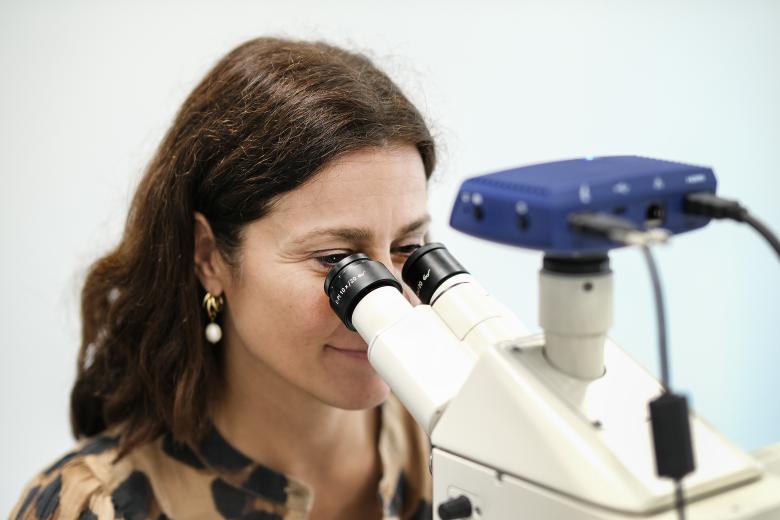Sustainable steaks and healthy hearts – synthetic meat and regenerative medicine
Having won the prestigious Perspectief grant, the MERLN-led FAB4FUTURE project develops a toolbox for the scalable production of stem cell-based tissue for medical purposes and cultured meat. Project leader Lorenzo Moroni and principal investigator Matt Baker on the creative synergy addressing weak hearts and gassy cows.
“We were thinking about how we can apply our skills and strengths in regenerative medicine in other areas to make a big impact,” remembers Matt Baker. MERLN’s expertise is engineering human tissues to repair parts of the human body, from bones to heart ventricles. “Engineering animal tissue is technically very similar, so Lorenzo thought there could be huge benefits to running the two research lines side by side.” Lorenzo Moroni adds that they hope to maximise results by using AI to bring together different technologies as well as to monitor and correct in real time parameters during the delicate fabrication process.
Synergy between healing and eating
“Cell agriculture is very good at scaling up production and make large amounts of cells, for example, a ground beef burger,” explains Baker. There is a race to capture this promising market, with roughly 150 companies worldwide competing. Singapore became the first country to approve the sale of cultured meat in 2020. Academic groups and companies from the Netherlands have been pioneers in the field; recently the Dutch government created a code of practice for safely conducting tastings of cultivated foods that is awaiting European market approvals. To be clear, this has nothing to do with vegan meat replacements, such as patties of soy meal and plant oil designed to look and taste like meat products. Cultured meat, which sounds like a cow that visits art galleries and the opera, is e.g. beef grown from a small cell sample of beef. It is biologically almost the same as beef and is targeted to have the same nutritional properties.
“In regenerative medicine, we are very good at tissue complexity, for example making skin or bone that has exactly the right properties. That is very similar to engineering a piece of muscle to become more juicy, more tasty, more tender,” explains Moroni and clarifies emphatically that it’s bovine muscle we’re talking about. While Mosa Meat already have a pathway to creating ground beef burgers, they are still looking for ways to create more complex tissue like steak, which consist muscle fibres, fat and connective tissue. “This is where the difference in taste and texture comes from – that’s why they are very close with ground beef but why a steak is still a challenge.”

Matthew Baker is Associate Professor at the Department of Complex Tissue Regeneration and the Department of Instructive Biomaterials Engineering at MERLN.
Scale and precision
The goal is to produce a steak that wouldn’t look out of place in a restaurant, up from a bean-sized chunk recently reported in the literature. While scalability is the focus, taste and texture also have to satisfy consumers. Baker also hopes that they will be able to rid the process of all animal products. On the medical side, precision and functionality is key. Current applications range from smart band-aids that accelerate healing to in vivo models of functional tissue for drug testing. Here, scalability is a limiting factor.
Letting pluripotent stem cells differentiate into cardiac cells and using hydrogels to help the tissue grow in such a way as to emulate a heart ventricle is exactly as complicated as it sounds. Baker explains that a highly skilled worker can make maybe three small tissue grafts per day – if nothing goes wrong. That is the equivalent of 3 grams. “Through automation, we hope to increase the speed so much that high throughput testing is feasible. This would be a big step forward for developing medical treatments.” In the long run, these possibilities for upscaling and accelerating cell manufacturing will make MERLN’s work benefit more people, potentially also in less wealthy countries.
Two major societal problems
The importance of the project’s medical side is clear since cardiovascular diseases are the number one cause of death worldwide. Maybe more surprisingly, animal agriculture is a major polluter and driver of the climate crisis. From habitat destruction to water pollution and emissions: it is one of the meatiest problems humanity faces. Meadows and pastures occupy a quarter of the earth's ice-free terrestrial surface. Meat accounts for nearly 60% of all greenhouse gases from food production, and a third of all global emissions. 80% of the world's soybean crop is fed to livestock. “I’ll be honest,” Moroni concedes, “when we started brainstorming, I had no idea about any of this. I was shocked when I read the numbers. The potential impact is enormous.”
Maastricht region a hub of biofabrication
FAB4FUTURE has won the NWO’s prestigious Perspectief grant worth €3 million over five years. NWO has awarded five such grants to broad, cross-disciplinary consortia involving industry, civil society organisations and governments for research into key technologies that address societal challenges. MERLN has brought together knowledge institutes, companies and social partners. “It took two years to get it granted,” Baker remembers. “You have to involve many industry players and obviously, their priorities change fast, so keeping all parties engaged was quite intense at times. Everyone wanted to work together on this but ironing out the details required a lot of last minute calls.”
Scoop
The Leiden company Meatable recently had a scoop. It is the first Dutch cultured meat company that received permission for a tasting session, after an extensive assessment by a committee of experts appointed by Stichting Cellulaire Agricultuur Nederland (the Dutch foundation for Cellular Agriculture). A select group was allowed to taste a few bites of pork sausages developed by Meatable. UM spin-off Mosa Meat, which makes hamburgers from the cells of cows in Maastricht, will probably be next, as it will have its first tasting in May. The Netherlands is the first country in Europe where cultured meat can be tasted.
“On the academic front, we’ve brought together the two biggest biofabrication centres in the Netherlands, in Maastricht and Utrecht, as well as a key player in AI and modelling in Delft,” explains Moroni. The consortium also contains biotech, biomed and cell agriculture companies from across Europe, prominently among them UM spin-off companies Mosa Meat and ReGEN Biomedical. Maastricht and its surroundings are well represented. “The investment in technology and attracting international talent has paid off,” says Baker. “Together with our European partners, we now have enough talent to compete on the biggest stage.”
Baker adds “even just ten years ago, a project like this wouldn’t have been possible because we didn’t have enough highly skilled workers and institutional expertise to pull it off.” Both stress the importance of the regional ecosystem: talent coming in from abroad, graduating at MERLN and then moving to companies and institutes close by. Ideas can spread and develop informally “over a cup of coffee” because people know each other and all have additional networks where they have come from.
Learn more about FAB4FUTURE here.
Text: Florian Raith
“Together with our European partners, we now have enough talent to compete on the biggest stage.”
Matthew BakerAlso read
-
The University Fund Limburg's new Annual Fund Campaign is live!
Every year during the holiday season, the UM community comes together to uphold a special tradition: supporting projects that contribute to a healthier, fairer and more sustainable society. Will you join us?
-
SBE researchers involved in NWO research on the role of the pension sector in the sustainability transition
SBE professors Lisa Brüggen and Rob Bauer are part of a national, NWO-funded initiative exploring how Dutch pension funds can accelerate the transition to a sustainable society. The €750,000 project aims to align pension investments with participants’ sustainability preferences and practical legal...
-
Fresh air
Newly appointed professor Judith Sluimer (CARIM) talks about oxygen in heart functioning and the 'fresh air' the academic world needs.